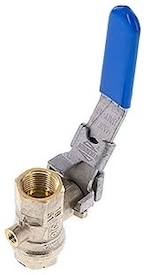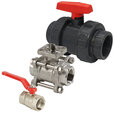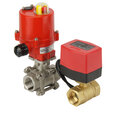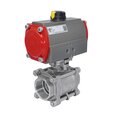Ball Valve With Drain Port

Figure 1: Ball valve with drain port
Ball valves with a drain port use this feature to drain fluids or debris from the system. They are often used in applications where it is necessary to completely drain the system or remove residual fluid after shutting off the valve. These valves are available in brass or stainless steel housing and are operated manually. This article explores the features, selection criteria, and applications of ball valves with drain ports.
Table of contents
View our online selection of ball valves!
What is a ball valve with drain port
A ball valve with a drain port helps release unwanted or excessive fluid from a pipeline. The valve allows for easy draining of the contents of a pipeline or tank without having to remove the entire valve. The valve accomplishes this by one of the following mechanisms:
- Using the handle: Rotating the ball valve by 90 degrees will open or close the valve. If the handle is perpendicular to the pipe, the inlet port is closed, and the outlet port is vented to the environment via the drain port.
- Using a drain tap: Certain ball valve models have a separate tap to operate the drain port. The valve can be closed using its handle, and the tap is opened to release residual fluid from the drain port that is connected to the outlet port. However, ensure the valve is completely closed before opening the drain port to avoid any unintended leakage or discharge of fluid.
A ball valve's drain port is typically smaller than the main valve port, so the residual fluid may take some time to drain out completely.
Applications
A ball valve with a drain port is typically used under two circumstances:
- Depressurize compressed air systems: When the handle is perpendicular to the pipe, the inlet port is closed, and the valve depressurizes the piping system through the venting borehole. As a result, the pressure inside the piping system is reduced to a safe level, making it easier and safer to carry out maintenance or repair work on the system.
- Removing water from a line: Water left in the spigot or valve can freeze and expand during winter, which can cause the pipes to burst and result in costly damage. To winterize a residential outdoor spigot using an indoor ball valve with a drain port, first, turn off the valve to stop water flow to the spigot. Then, open the spigot to allow any remaining water in the line to drain out. Finally, open the drain port on the ball valve to drain any water trapped inside the valve.
Read our ball valve applications article for for details on the various applications of ball valves.
Selection criteria
While ball valves with drains can be used for normal shutoff applications, they may not always be necessary or cost-effective for all applications.
- Standard ball valves are often less expensive and simpler in design, making them suitable for applications where the added features of a ball valve with a drain are not needed.
- A ball valve with a drain port has an additional opening that can increase the risk of leaks or contamination if improperly used.
Consider the following criteria while selecting a ball valve with a drain port:
- Connection size and type: Available sizes range from 1/8 inch (3.18 mm) to 2 inches (50.8 m) and include threaded end connections (BSP). To prevent leaks and ensure a secure fit, ensure compatibility with existing piping systems.
-
Material: The valve body can be brass or stainless steel, and the seal is typically made of Teflon (PTFE).
- Brass: Brass is suitable for applications up to 20 bar (290 psi) and 100 𐩑C (212 𐩑F). It is ideal for general-purpose applications where moderate pressure and temperature are expected.
- Stainless steel: Stainless steel is suitable for applications up to 200 𐩑C (392 𐩑F) and is recommended for high-temperature applications or where corrosion resistance is critical.
-
Flow rate (Kv): The Kv value indicates the flow rate through the valve. A higher Kv value means a higher flow rate.
- To minimize pressure drop, select a valve with a larger bore size for applications requiring high flow rates. A smaller bore size may be sufficient for low-flow rate applications, but ensure it meets the system's flow requirements to avoid inefficiencies.
-
Venting hole: The venting hole is available in sizes such as G1/4 inch, 2.5 mm, 3 mm, M5, and G1/8 inch.
- Choose the venting hole size based on the required venting capacity. A larger venting hole allows for quicker drainage or venting, which is crucial in applications that require rapid pressure equalization. Ensure the venting hole size matches the system's requirements to prevent over-pressurization or inadequate venting.
FAQs
What is a ball valve with a drain port used for?
A ball valve with a drain port controls fluid flow in a pipeline while providing a convenient way to drain the system.
What are the benefits of using a ball valve with a drain port?
The main benefit of using a ball valve with a drain port is that it provides a convenient way to drain the system without additional valves or fittings. Additionally, it allows for easy maintenance and repair of the system.









